This morning we met the tour guide at the gas station in town at 0830. He is a Polynesian fellow named Vincent. Vincent was driving a four wheel drive pickup with benches in the bed, which seems to be standard for tour companies in these parts. We loaded into the back and we drove for a ways. The road parallels the water, with scenic views of the lagoon. Most of the area around the bay had development of some sort on it, mostly houses. Of course, it was very green and lush.
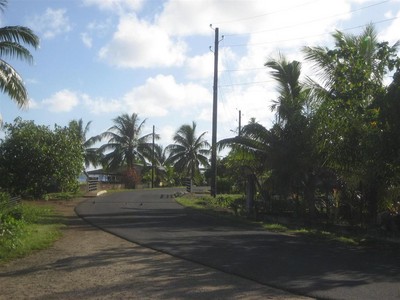

We pulled into a church parking area where another 6 people were waiting. Once everyone was loaded into the bed of the truck, Vincent gave us the stats of the island 5,000 people, main industry vanilla farming, etc. He showed us on a map where we were going and told us what we would be seeing. Then he played a couple songs for us on his Ukulele, which set the tone for a fun adventure.

After a short drive on the main road, we turned off onto a dirt road that went into the interior of the island. The road was steep, full of potholes and scary. We were really glad we had not rented a car because there was no way you could do this road without four wheel drive.
Vincent stopped often to tell us about the local flora and fauna of the island as he passed plants of interest. Like the Marquesas, a lot of fruit is grown on the island. We saw breadfruit, papaya, star fruit, pampelmousse, noni, and of course, coconut. Vincent picked a few pieces of each fruit for us if they were ripe. He opened up a noni and passed it around for us to smell. It smells just like Camombere, that super stinky French cheese. It is nasty smelling.
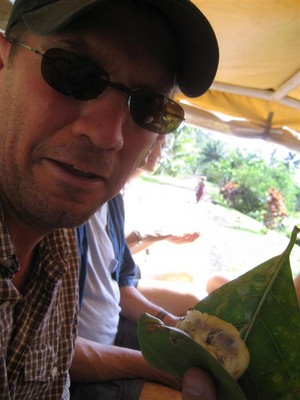
While driving along the main road we had noticed several low, wide structures that looked like little roofs with sliding trays. We found out they are coconut drying trays. The coconuts are opened, broken into pieces, and put on the trays to dry. We passed a pineapple plantation. They were harvesting, so Vincent grabbed a couple pineapples out of the truck and threw them at us, too.
Much to Eric’s delight, we passed a vanilla plantation and we got the full explanation of how vanilla is made. Vanilla plants are vines with distinctive flat leaves and pretty, white orchid flowers.
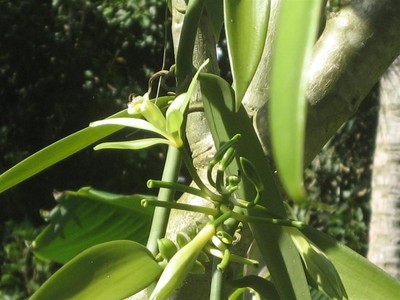
The flowers are bi-sexual, meaning they have both male and female reproductive parts in the same flower. Most flowers are pollinated by insects, but not vanilla. Each vanilla flower must be pollinated by hand. They break the stamen and put the pollen on a small stick, then smear the pollen along the female part of the flower.
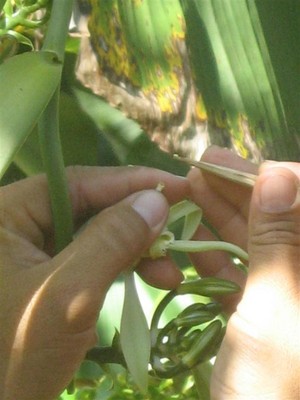
Vincent said the plantation workers come every day during the four month fertility season to look for new flowers to pollinate. They break the stamen open to get the pollen, then use a small stick to put the pollen on the female part. After nine months, the beans are picked, then left to dry in the sun another nine months. Vanilla beans actually look like pods. After finding out how labor intensive it is to grow vanilla, it is no wonder it is so darned expensive.
As we climbed the mountain, the views became prettier and prettier. At the peak, the views were spectacular. It is probably the most beautiful spot we have been in yet. You could see two bays, the lagoon, Raiatea in the distance, and the ocean.
Looking north from the peak. Lagoon and reef motus.
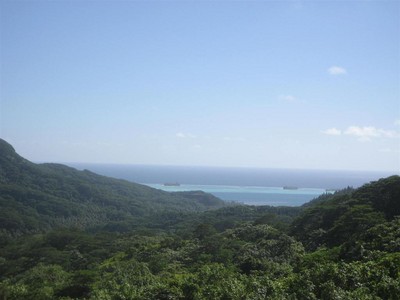
Looking east. Bay and lagoon.
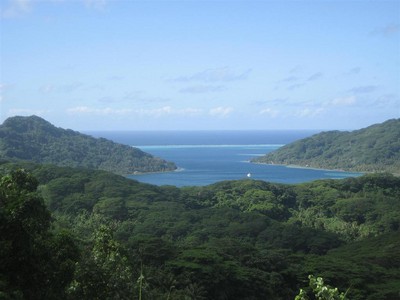
Looking south. A different bay, lagoon, and Raiatea in the distance.
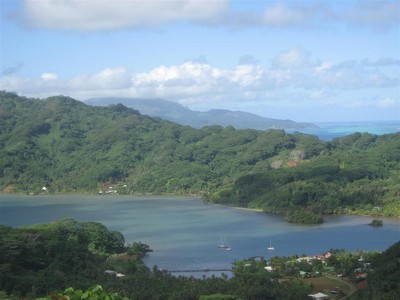
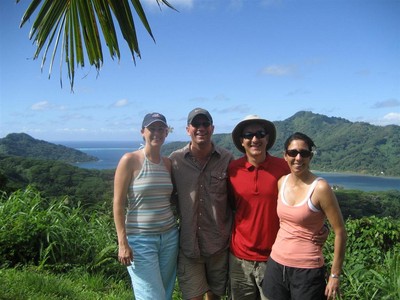
When we were done taking photos, Vincent gave us a brief lesson in the art of tying pareus. Pareus are the traditional clothing worn by the natives, and it is basically a piece of rectangular cloth. They are incredibly multi-purpose and can be tied dozens of ways for both men and women. Vincent showed us the most basic couple of ties for men and women.
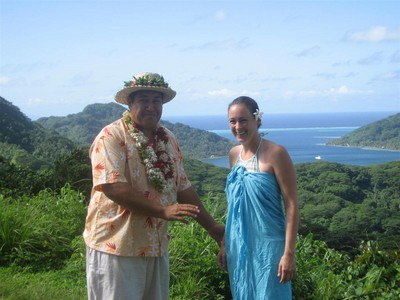
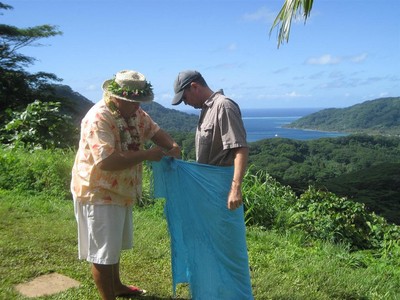
Then we got a lesson in the art of opening and cutting a coconut. What took Pete a half hour of hard labor took Vincent about ten seconds. Pete volunteered to be Vincent’s guinea pig, so now Pete is ready to tackle another coconut. When you crack a coconut open there is clear liquid inside, called coconut water. Coconut water is light and refreshing and a common beverage for the islanders.
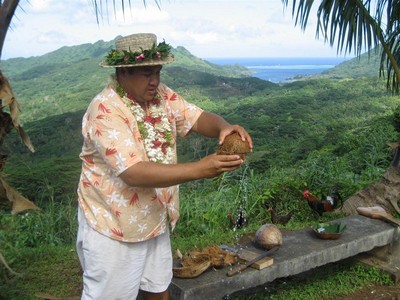
Vincent also showed us how to make coconut milk. He shredded the coconut using a special tool, then squeezed the shredded pulp, and out came the milk. The milk is used more for cooking.
Vincent then brought out a fruit tray. We ate fruit while Vincent played songs for us on his Ukulele. It was a nice touch.
After we were done eating, we continued on the same road, which took us back down the mountain to the other side of the island. We stopped at a small market that sold Vanilla beans so we could buy the beans, snacks and beverages. This is the first store we have been to in all of French Polynesia with no Tim Tams. It is a wonder they stay in business without such an essential food item.
We piled back in and drove around the main road for quite a ways. The drive was really pretty. We went around several bays. Our last stop was a pearl farm. Finally, we made it to a pearl farm tour. Once we left the Tuomotus, we figured we missed our chance. This pearl farm looked much the same as the ones on Manihi, with several bungalows on the shore and a dock with a small building at the end in the water.
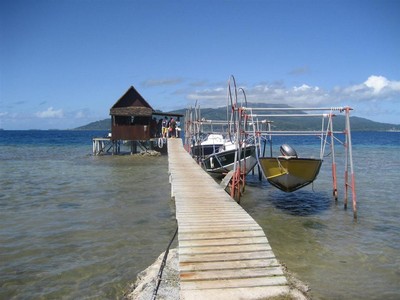
We all marched out to the small structure where a young French man awaited us to explain the process. They start when the oysters are young. The oysters are opened just a small crack, anything bigger will kill the oyster. A mirror is inserted. If the oyster has an especially colorful shell, it becomes the seed oyster. If not, it has the seed implanted in it. The grafter takes a small piece of the seed oyster and a round piece of mother of pearl, called a nucleus and imported from oysters in Mississippi, and surgically implants them in the female reproductive area.
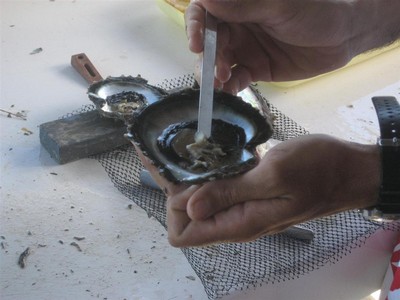
They put several oysters in a bag and put the bags in seven meters of water for a year and a half. During that time the seed is coated with one to two millimeters of the mother of pearl secretion that comprises its shell, making a pearl. After the time is up, the bags are pulled in. Oysters that made nicely shaped pearls get another seed put in them, oysters with deformed pearls are discarded. The reason that you get colored pearls down here instead of white pearls is because they oysters that naturally live here produce more colorful mother of pearl secretion. The pearls are called black pearls, but they are really shades of gray. Some are lighter, some are darker, and many have tints of blue, green, purple, pink and yellow.
From there we went to a showroom to learn about how pearls are graded. Depending on the grade and size, they run anywhere from $40 each to thousands each.
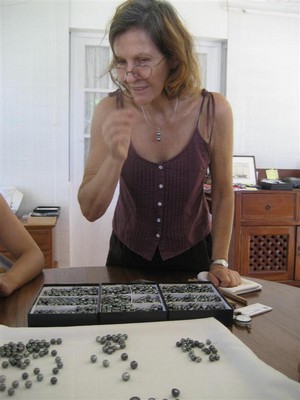
After the lesson, a pile of jewelry made in house was pulled out for us to look at, then we were ushered out so the next group could get the lesson. There was no jewelry out on display for you to peruse at your leisure; just pretty much laid out on the table in piles for you to make a decision within minutes.
When we first arrived at the pearl farm we asked Vincent if he knew of a restaurant where we could get lunch. When we got back in the truck, he told us he had made arrangements with Chez Louise. He would drop us off there and they would take us back to the dinghy. Nice. We also noticed all the fruit rolling around the back of the truck was now all piled into the backpack we had left back there. Apparently, Vincent had taken a liking to us and wanted us to have all the fruit. Very nice.
After a few minutes of more scenic driving, we got to Chez Louise. It is a small, outdoor restaurant overlooking the water with a spectacular view. It was serene and relaxing. We were the only people there.

An older Polynesian woman welcomed us and told us to sit down. She asked us what we wanted to eat. We looked at her blankly. She said “You like fish?” and we all said yes. A few minutes later out came salads, followed by an entree of tuna and rice. The food was excellent and the portions were enormous, literally four times as much tuna as you would normally get in a restaurant. After the food came out, two late teen boys hopped into a boat tied at the end of the dock and took off. She explained that her older son was the chef, and now that lunch was over, he and her younger son were going surfing. That is the life. After we were done eating, she brought us some pampelmousse for dessert.
Shortly after, an older man took us the few miles to the dinghy dock and we went back to Kosmos. As we passed the snooty hotel in the dinghy, we noticed that the motu that the hotel was on wasn’t as big as we had thought. There was a small break separating two motus that we hadn’t noticed before. There were quite a number of people snorkeling in that area. Maybe this was where the Coral Gardens were located? Back at Kosmos, we went for a swim, made dinner, and played Wii for the rest of the night.

what a wonderful day! glad eric finally learned about his vanilla plants! now i understand the expense as well!
Hi,
Thanks for the beautiful pictures! I also love coconut water!
Here in California I drink ONE Coconut Water and makes me feel a bit closer to home!
http://www.onenaturalexperience.com